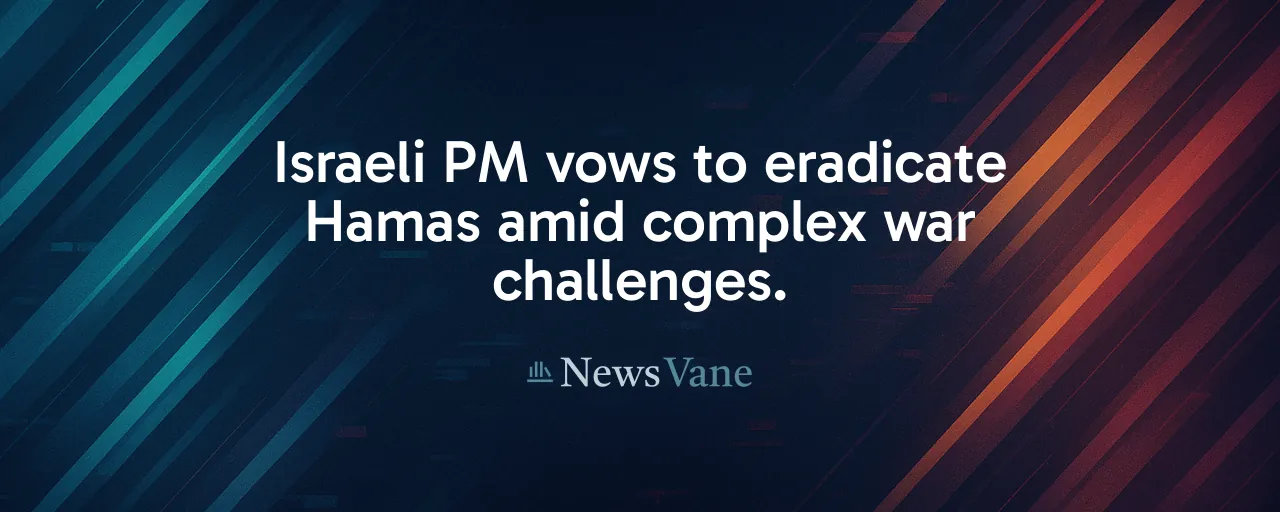A Bold Pledge Amid a Brutal War
Israeli Prime Minister Benjamin Netanyahu's recent vow to eradicate Hamas has reignited global attention on the Gaza conflict. Speaking with unwavering resolve, he declared that the militant group's reign, and any notion of a 'Hamastan,' will end. This pledge, delivered amid a war that has raged since October 2023, underscores Israel's determination to reshape Gaza's future. The path to that goal remains fraught with challenges, raising a critical question: can security be achieved without sowing seeds of further unrest?
The conflict's toll is staggering. Over 50,000 Palestinians and 1,200 Israelis have died, with Gaza's economy in ruins and Israel facing economic strain. Netanyahu's words resonate with many Israelis seeking safety after Hamas's brutal attack, which killed civilians and took hostages. The complexity of dismantling an entrenched group like Hamas demands more than military might. History suggests that lasting stability requires addressing governance, reconstruction, and regional dynamics.
The Limits of Military Solutions
Hamas, born in 1987 and in control of Gaza since 2007, has weathered multiple Israeli offensives. While Israel has degraded its tunnels, rockets, and leadership, the group's guerrilla networks persist. Military scholars point out that wiping out ideological insurgencies is rare. Past efforts, like Israel's 1982 campaign against the PLO in Lebanon, achieved tactical wins but failed to eliminate the group's influence. Hamas's decentralized structure makes it similarly resilient.
The human cost of the current campaign is undeniable. Gaza's infrastructure lies in tatters, with widespread displacement and famine warnings. Israel's economy, too, faces a multi-year drag from war costs. These realities highlight a hard truth: even if Hamas's military capacity is crushed, the absence of a viable alternative risks chaos. Analysts warn that a power vacuum could fuel new insurgencies or empower other militant factions.
Governance as the Key to Stability
A critical issue often overshadowed by military goals is who will govern Gaza after the fighting. Without a clear plan, the region could spiral into disorder. Centrist think tanks propose a hybrid approach: targeted counter-terror operations paired with international oversight to secure borders and prevent rearmament. An interim technocratic administration, potentially backed by Arab states, could manage reconstruction and basic services, sidelining Hamas without leaving a void.
Rebuilding Gaza's economy, which has collapsed by over 80 percent, is equally vital. Donor nations face fatigue, and funding remains uncertain. Investment in schools, hospitals, and jobs could curb radicalization and give Palestinians a stake in stability. Historical efforts, like post-World War II reconstruction, show that economic recovery, when paired with accountable governance, can break cycles of violence.
Balancing Security and Diplomacy
Israel's security concerns are real. The October 2023 attack exposed vulnerabilities, and the return of hostages remains a priority. Prolonged warfare, however, risks alienating allies and escalating tensions with regional players like Iran or Hezbollah. A multi-phase ceasefire, exchanging hostages for prisoners and easing Israeli operations in populated areas, could de-escalate while addressing immediate needs. Egypt and Qatar, already mediators, could play a larger role in enforcement.
International involvement offers another layer of promise. A robust monitoring mission, led by neutral parties, could deter smuggling and ensure Hamas does not rearm. Such mechanisms have worked in past conflicts, like the UN's role in Lebanon. Pairing these steps with talks on Palestinian self-rule could address long-term grievances, reducing the appeal of militant groups.
Learning From the Past
The Gaza conflict is not Israel's first attempt to neutralize a militant threat. The 2014 war aimed to cripple Hamas but ended with the group rebuilding its arsenal. The 2007 blockade also curbed some activities but entrenched Hamas's control. These outcomes suggest that security gains need to be cemented with political and economic progress. Ignoring this risks repeating a cycle where tactical victories give way to strategic stalemates.
Both sides face internal pressures. In Israel, divisions over military service and war aims deepen social rifts. In Gaza, civilians endure trauma and loss, fueling despair. Addressing these human costs through aid, mental health support, and dialogue could rebuild trust. History shows that even bitter adversaries, like post-apartheid South Africa, can find common ground when practical steps align with shared needs.
A Fragile Path to Peace
Netanyahu's vow to eliminate Hamas reflects a deep desire for security; the road ahead requires more than resolve. Military action alone cannot erase ideology or rebuild a shattered region. A balanced approach, blending targeted operations with governance reforms and diplomatic outreach, offers the best chance to break the cycle of violence. Gaza's future depends on pragmatic steps that prioritize stability over vengeance.
The international community has a role to play, from funding reconstruction to enforcing ceasefires. Regional powers, too, can bridge divides, leveraging their influence to support a framework that ensures security and dignity for both Israelis and Palestinians. The stakes are high, and so is the potential for a new chapter.
Ultimately, lasting peace demands courage to move beyond destruction toward creation. By focusing on governance, economic recovery, and mutual security, the region can escape the shadow of 'Hamastan' and build a future where both sides thrive. The question is whether leaders will seize this chance before the next spark ignites.
